Rachel Neumeier's Blog, page 100
June 14, 2022
Flashbacks
Here’s a post by James Scott Bell about flashbacks: The Fundamentals of Flashbacks
I like this post because it points to a use of flashbacks that I hadn’t thought of, even though I’ve used flashbacks that way myself:
A flashback is used to give us essential backstory information about a character and/or the plot. It helps readers understand why a character is acting a certain way in the story present. Or it may reveal plot points to give us a fuller understanding of the story beats. Often it’s a combination of both.
There’s also a strategic use. A flashback can be a suspense interlude. When you leave your main story at a point where the readers are on tenterhooks, they will read that flashback in a pleasurable state of anticipation—which is what drives a page turner.
A suspense interlude! I immediately recognized that because I used a flashback like that in Suelen.
Two more days to preorder this book, by the way!
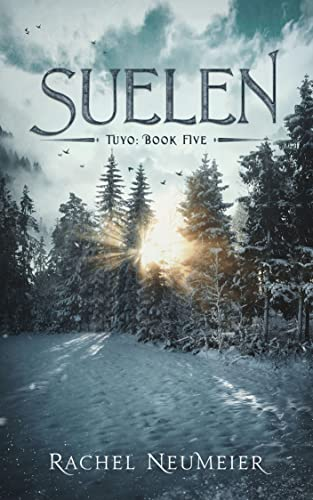
That wasn’t the only reason I put in two flashbacks. I did that for several reasons:
First, flashbacks allow the reader have a couple of scenes with Aras, who does not appear in the actual story otherwise. I like Aras, I hope everyone else likes Aras, I’d be sorry not to let him appear in a Tuyo-world book, so I did flashbacks just to the previous day in order to show Suelen’s meeting with him.
I could, obviously, have written the story straight from front to back, but inserting that meeting as flashbacks let me do several things that straight chronological order wouldn’t have allowed.
First, by using flashbacks, I could start the story at almost the moment Suelen’s decision to enter the winter country becomes irrevocable — the moment when he meets Ugaro warriors. After that, turning back is really not an option.
Second, by using flashbacks, I could split the meeting with Aras into two scenes and show one early in the story and the other later. That one meeting is therefore shown in chapter two and chapter seven. And why did I want part of it to be shown later in the book? Because, yes, that creates a suspense interlude, just as James Scott Bell says. I didn’t think of it that way … well, maybe I did. I certainly did deliberately break off at a suspenseful moment, put in the interlude, and then went back to the main story line.
For this particular story, I wasn’t using flashbacks to build backstory at all. Well, maybe a tiny amount, but seriously, not much. In general, I’m not crazy about using flashbacks for that purpose. I think that kind of flashback often makes me impatient. How about two sentences of backstory and let’s move on? I’m reading a book right now that made me feel exactly like that. I didn’t like the backstory scene; the important detail could have been conveyed in two sentences of telling rather than pages and pages of showing and I would have liked that a lot better.
Personally, despite the examples Bell provides as good examples, I very strongly (VERY STRONGLY) prefer authors to signal that they are entering a flashback with use of the past perfect OR with a chapter break OR both. I detest the use of the simple past tense at the beginning of a flashback. I mean, if the story is being told in third person past tense; in that case simple past is not appropriate for moving into a flashback. Shifting subtly from past perfect to simple past in the first paragraphs of an extended flashback is part of the artistry of storytelling and I hereby recommend that authors pay attention to that. I got plenty of practice at making that transition smoothly when writing the Death’s Lady trilogy, where almost the only fantasy elements in the first book are provided in flashbacks and the flashbacks are integrated into story-present conversations. Believe me, I focused hard on getting into and out of flashbacks smoothly and the biggest part of that is shifting from past perfect to simple past and then back to story present.
However, in that trilogy, I didn’t use flashbacks as suspense interludes at all, while that’s perhaps the primary function of the flashbacks in Suelen. Hopefully that will work well for readers! I’m really impatient for Friday, when Suelen will hit Kindle devises everywhere. Oh, that reminds me, I better make a note to hit publish on Thursday for the paperback.
By the way, I’ve had requests to do a hardcover edition for it. I hadn’t intended to because it’s rather short — remember, about 75,000 words — and hardcovers have to be 6×9, which will make it look very short indeed. But, hey, a couple requests plus I would kind of like it in hardcover myself, so I’ve asked the artist to do a hardcover cover for me. It won’t be ready by Friday, but it should be ready pretty soon.
Please Feel Free to Share:






The post Flashbacks appeared first on Rachel Neumeier.
June 13, 2022
Puppies: Seven Weeks!
Oh, they are SO CUTE now!
Also, even though seven weeks in not, strictly speaking, when we evaluate structure in puppies — we do that at eight weeks, and some people think ten is better — nevertheless, seven weeks is a great time to introduce the puppies to the concept of “stacking,” which means also to the concept of “treats.”
Here is a beautiful young Cavalier in a correct stack that shows her extremely good structure. Spoiler, she’s one of mine, now thirteen years old and in a pet home. But this is a great picture to use to discuss structure, especially because she had no coat to speak of at this age. I’m leaving this picture big enough you can see her structure properly.
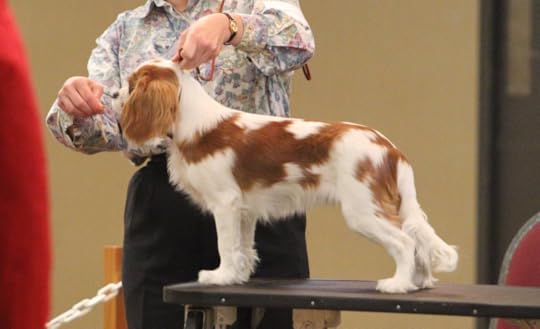
You see that smooth flow of her topline from the top of her head to the base of her tail? That is a correct topline for every single trotting breed in the universe. I realize you can’t see the top of her shoulder blade, we locate that by touch, but it’s about where that little snip of red color is pointed. This is excellent shoulder layback, which is why she has a nice long neck. Her front is excellent. Her rear is even better than her front. This is just how the rear should look. Great angulation. This is a wonderful youngster. Want to take her hiking on the Adirondacks trail? No problem. She’s built for it. Australian Shepherd, Collie, Siberian Husky, Vizsla, Golden Retriever, whatever, if the dog is supposed to be put together for an efficient trot, this is how that dog should be put together if you want efficient, smooth movement.
A dog put together correctly can go all day. A dog with bad structure will wear out faster, break down earlier, and unfortunately quite possibly suffer some degree of pain for most of its life. Sound structure leads to good orthopedic health for the dog’s entire life. Bad structure leads to orthopedic breakdown. Structure and temperament are therefore BY FAR the most important characteristics when looking at a dog; even type is way less important, and certainly color and markings and other cosmetics are right down at the bottom of things to consider. While I could pick nits when looking at the structure of the youngster pictured above, she is almost exactly what any correct trotting dog should look like. Some breeds — Standard Poodles, Norwegian Elkhounds, Dobermans, Boxers, etc — are built more square, but other than that, this is still basically the correct structure for all those breeds as well. Galloping breeds and digging breeds are put together somewhat differently, by the way, and of course dwarf breeds such as the Cardigan Welsh Corgi. Even so, very worthwhile to have a basic picture of correct, sound structure in your mind when selecting a pet, including a mixed breed.
Now, let’s have fun seeing how puppies look the very first time you try to set them up, by yourself, with a crappy camera in one hand and a treat in the other.
 Boy One.
Boy One. This is actually a pretty good stack! The picture is not really in great focus, but anybody can see this puppy is nice despite the puppy fluff getting in the way. His head is stretched out to get a treat, which pulls his neck down, but it’s a fine length of neck, implying a good shoulder. We really evaluate the front by touch; you set one finger on the top of the scapula and your thumb on the point of the shoulder and then look at the placement of the elbow in combination with those anatomical points. We also check the forechest by touch. How far forward does the sternum come? It should come well out in front of the legs when the legs are in the correct position. Not insanely far — that’s a common-ish fault in Weimeraners — but well out. If the puppy lacks forechest, the entire front may be too far forward on the body. You can’t see that through the fluff, though. (When you see judges touching dogs during a show, this is the the kind of thing they’re evaluating, and this is why they put their hands on a fluffy dog a lot more than on a smooth-coated dog.)
I believe this puppy’s topline is going to be very nice. His rear leg is back a bit too far, but I think his angulation looks good all the way around. Nice puppy. Solid, too, lots of bone. That’s a type characteristic, not a structural characteristic, but it’s good to see.
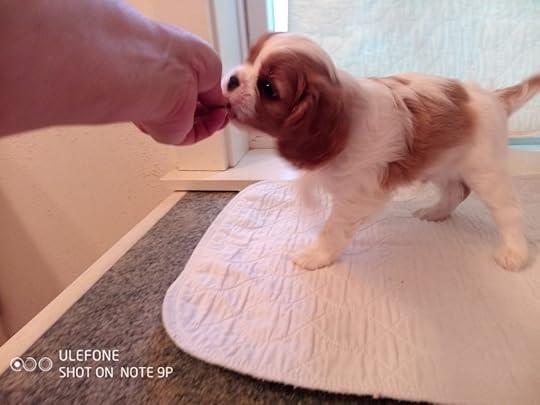 Boy Two
Boy TwoHa ha ha! Wow, treats, ooh, let me get the cookie! Boy Two had been asleep, but he sure woke up when he tasted his first liver brownie. This is a terrible stack, but a really cute picture. It’s not your imagination if you think he looks less fluffy: Boys One and Three are fluffy, Boys Two and Four less fluffy. This is natural variation. Regardless, all the fluff will shed out and the puppy will be very short-coated at around six months, then the adult coat gradually comes in.
I did get a better picture of him, but not a cuter picture, so this is the one I’m posting here. (Also, you should see the zillion extremely blurry pictures I deleted. This photo session took about ten minutes per puppy, or forty minutes of my morning.) Boy Two looks overall a lot like Boy One in structure.
 Hefty Boy Three
Hefty Boy ThreeWhat a little pudge! This guy cleans up his food in a hurry and then I have to move him out of the way so the other puppies can get their share. He’s up to four and a half pounds as of this morning, half a pound bigger than the next biggest, a full pound bigger than Boy Four. He’ll almost certainly lose the pudginess between four and six months, but I doubt he’ll ever be a picky eater.
He’s fluffy, exaggerating the hefty look, but if you ignore both fluff and pudginess, he’s quite nice. His front is invisible, but his length of neck looks fine. He’s toeing out in the rear, practically universal in young puppies, I’m not concerned about that. If you look, you’ll see they’re all doing that. I can see his pasterns are straight up and down, nice angulation for sure. We also evaluate structure via movement and this puppy trots very nicely. They all do. Much better than bunny-hopping in a puppy this age; we like to see a straight, smooth trot right from five weeks on.
I like Boy Three a lot. I love his attitude — I think he would make a very good show dog despite the forward marking on his face, and I’m sure he’d make a great performance dog. He’s extremely eager to please and even more eager to earn treats! I got an especially delightful face shot of him this morning, so here it is:
 Happy puppy!
Happy puppy!Moving on to the last puppy …
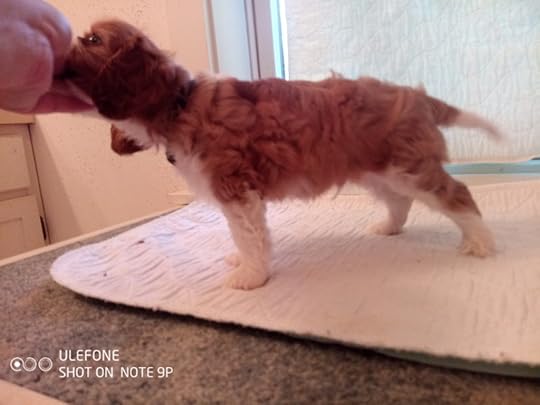 Boy Four
Boy FourYou can see how very heavy his markings are compared to even heavily marked Boy Three! We call this a blanket Blenheim. You see a lot of blanket Blens and blanket Tricolors in the show ring these days. It’s not my personal preference. Nice puppy though! Long neck = good shoulder, plus a smooth topline which also means good shoulder. You don’t want the impression of a sharp angle where the neck joins the body; that always means a very upright shoulder, which is terrible for efficient movement. (Short steps, pounding gait, poor endurance, potential breakdown of front pasterns, if there’s an elbow problem, you’re likely to find out about that too as the constant orthopedic stress produces eventual breakdown all up and down the front.) Nice tail set. They all have good tail set, which is good to see because it probably means a correct croup and pelvis. They stick their tails up when playing, but see here, they all have good low tails when they’re just standing. That’s what we like to see.
Boy Four also has better bone than I really thought he might. That’s not important for function, but it’s correct type for a Cavalier; they’re not supposed to look dainty and fragile. They’re supposed to have some heft to them. This little dude is small, but he’s well proportioned. I like his body a lot, in fact. I would need to put my hand on his front to really evaluate his elbow placement. I think it will turn out to be fine, though offhand the best front looks — to the eye — like perhaps Boy One.
This is a quality litter, honestly. I’m quite pleased to see Leda produce such nice puppies. Two forward markings on the face, but structure and type are much more important than a little cosmetic failing like that. If I wanted a boy, I’d be happy to keep any of the top three puppies here. I think Ish has probably contributed his beautiful head to at least those three puppies. Boy Four has had a narrower head so far, but it may be starting to broaden at this point. Here he is again below. That’s not a bad head at all and I think it will improve.
 Boy Four, ready to bounce forward — he’s come a long way from that tiny 4.25-oz infant!Please Feel Free to Share:
Boy Four, ready to bounce forward — he’s come a long way from that tiny 4.25-oz infant!Please Feel Free to Share:







The post Puppies: Seven Weeks! appeared first on Rachel Neumeier.
FINISHED! AT LAST!
Wow, I can’t even tell you how glad I am to have finished — FINALLY! AT LONG LAST! — a full draft of Invictus.
It’s 179,000 words, 605 pp, which is (of course) longer than my maximum estimate a month ago — I overshot that estimate by nearly 20,000 words, which is probably about par for the course even when I try to allow for that. Given that, I guess it’s reasonable that I also overshot the time expected by 12 days.
I’m not interested — I’ve never been interested — in even thinking about traditional publication for this one. I don’t think it’s right for that. I think it’s perfect for self-publishing. Publication will be in 2023 sometime; there’s no way to handle all the revision and proofing and everything this year, not if I want to focus on Tasmakat right away, which I do.
Therefore, next steps with this manuscript:
–Set it aside for a good while because I’m tired of dealing with it and eager to get into Tasmakat.
–Re-read the back half and revise to clear out all the many boldfaced sentences, which all point at continuity problems, hopefully minor.
–Decide whether to get rid of one (very minor) character and the (somewhat important) episode in which she’s important. The way the climactic scenes developed, she’s probably not necessary, that episode is probably not necessary, and cutting both will probably smooth out the action. But I’m not sure. Reading it again after a break will help me decide.
–Trim. As a rule, I cut about 30,000 words, which is about 100 pages. (Yes, really, that’s about average for me.) (Yes, I wish I didn’t have to do that.)
–Send the draft to my first beta readers. I will want these readers to focus on big, big issues — anything about continuity, plot, or worldbuilding that does not make sense, anything that feels like a serious problem with characterization. I might see if Sharon Shinn has time and would like to read it, since the romance thread here is pretty strong and as she’s a romance author, I would like her take on that aspect. Remember, she’s the one who said plaintively about Keraunani, “Wait, can’t you show one kiss at the end?” Of course I needed a kiss at the end!
–Additional revision based on their feedback.
–Send to my best editorial beta reader (Hi, Kim!)
–Additional revision.
–Proofing
And by then I will have gotten a cover, set a publication date, and put it up for preorder. I want a spaceship cover, the exact kind that makes me roll my eyes because it’s so generic, but in this case as long as the artist will paint the spaceship black and put INVICTUS in red letters on the spaceship, that kind of cover is perfect. A spaceship on the cover declares This Is Science Fiction, which prevents people from thinking that it must be fantasy because I only write fantasy and then being surprised. I don’t want that.
If Invictus is still up at ~180,000 words after revision — which is fairly likely, because after I trim, I tend to add back in words during revision — anyway, if it’s still on the long side like that, I will almost certainly cut it in half and publish it as a duology with a cliffhanger in the middle. That is because:
a) it’ll be long enough to justify being cut in half;
b) the division point in the middle rises organically out of the plot; there’s nothing in the least contrived about it;
c) it’s obviously better as far as marketing goes to publish it as two books with a very low price on the first and a significantly higher price on the second. That way readers who don’t actually like the story haven’t invested much in the front half, while absolutely everybody who reads far enough to hit the cliffhanger will definitely buy the second book. Plus forever after I will be able to run sales on the first book to boost visibility of the duology and increase sales on the second.
The downside is that of course I would need a second title and cover. That’s the only downside, though. I think it’s fair to end the first book with a cliffhanger given that the second would be published the same day.
Please Feel Free to Share:






The post FINISHED! AT LAST! appeared first on Rachel Neumeier.
June 10, 2022
Extra Puppy Post
Okay, first, here’s another cute video! Very brief, but Morgan REALLY wants the puppies to chase her. They are just a hair too young to really join in games of tag with adult dogs, but it’s adorable to watch them make their first attempts.
Also, here’s a cute picture that shows how I start crate training. The crate is just there in the living room. Naamah gets her meals in the crate because she’s slow to finish her food and this way I know she’s the one who’s eating it.
Anyway, these two puppies crept in there to yearn after Naamah’s cow hoof toy. She wouldn’t let them have it, so they just went to sleep instead. If I were keeping them, they’d move very easily from sleeping crowded together in a crate with the door open –> sleeping with an adult dog in a crate with the door closed.

If you ever have two puppies at the same time, by the way, it’s important to take them for walks separately and crate them separately and train them separately. Every day, not just occasionally. Otherwise you can get sibling syndrome in which one puppy becomes massively overdependent on the other (or both become overdependent at the same time). Either way, both puppies develop distorted personalities, often seriously distorted. Here’s a post about this. Chatting with very experienced dog people makes me feel that breed is not important as a predictor, as it’s a rather common problem for all sorts of wildly different breeds.
Nothing like this ever happens to my puppies when I keep littermates, which I have done several times, nor to breeder friends of mine who have kept littermates. That’s probably because our babies have an entire pack structure to fit into and therefore don’t focus just on each other in such a pathological way. Also, of course I train each puppy separately; nobody can train two baby puppies to both do basic obedience at the same time. You have to focus on one and then the other. Even so, I generally crate each puppy separately at night, with a friendly babysitter adult rather than a littermate. During the day, if the babies want to crowd into a crate together, that’s fine. I leave crates open, and it’s not unusual to see two or three dogs in one crate, a lot like the above picture, except all adults, so they’re kind of lying on top of each other. My three young girls like to do that, sometimes with both boys crowded onto the dog bed on top of the crate.
Ah, I really want to keep a puppy! But two boys are enough! I hope Morgan and/or Naamah will give me a lovely little female puppy later this year. Preferably both of them!
Please Feel Free to Share:






The post Extra Puppy Post appeared first on Rachel Neumeier.
June 9, 2022
The Evolution of Gaslamp Fantasy
Here’s a post at Book Riot: THE BIRTH AND EVOLUTION OF GASLAMP FANTASY
[G]aslamp fantasy is fantasy that takes places any time during the 1800s, with some exceptions. Under its umbrella are Regency and Victorian fantasy, and some gothic fantasy fits as well. Some may also dispute whether steampunk is a sub-genre of gaslamp fantasy or vice versa …
Gaslamp fantasy was birthed from exploding public interest in the fantastical, supernatural, and the occult during Queen Victoria’s reign, though at the time it was just called fantasy, fairytales, or the fantastical. … Since then, gaslamp fantasy has evolved and now encompasses much more than strictly Victorian England. … While still set in and around the 19th century, authors are envisioning fantasy tales in places other than England, such as in America during the civil war.
I guess? I believe I was simply thinking of Gaslamp Fantasy as a more fantasy-feeling Steampunk — Steampunk but with fewer gears, I suppose. And less steam. The above therefore sounds about right. Around a 19th Century level of technology, with fantasy. How is that different from Historical Fantasy that happens to be set in the 19th Century? I suppose I would say: It’s not different. Gaslamp Fantasy is a subset, not of Steampunk, but of Historical Fantasy. It’s is a sister taxon, so to speak, of Steampunk.
The Book Riot post provides examples. Let me see … Jonathan Strange and Mr Norrill, yes, that’s the one I was thinking of. Zen Cho’s Sorcerer to the Crown, which I believe I tried, but the opening didn’t really pull me in. (I know lots of you loved it and I should therefore try it again.) Ah, here’s The Conductors, which someone at Book Riot definitely loves because this is the third post I’ve seen that featured this book. It’s one where I have a sample, but you all have confirmed that it’s pretty dark and maybe not something to read until I’m in the mood for that.
One more, and this one is new to me:
Under the Pendulum Sun by Jeanette NgFor those lookin for some gothic horror mixed with their gaslamp fantasy, I give you this haunting and alluring novel. Published in 2017, Under the Pendulum Sun takes on Christianity vs. the meddling and trickster Fae. Victorian missionary Catherine Helstone goes to Arcadia, the land of the Fae, in order to find her brother Laon, who went missing on his missionary trip. There, she resides in the mysterious house of Gethsemane, trying to unravel the mystery of the missionary that arrived before her and her brother, who tried and failed. It’s really unlike any book I’ve ever read, and I mean that in the best possible way.
A lot about that sounds promising. Have any of you read it?
Meanwhile!
Here’s a Tor post: What is Gaslamp Fantasy?
This post was referenced in the Book Riot one. It’s interesting because the author of this post, Terri Windling, provides a list of examples and includes …
Pride and Prejudice and Zombies.
Well. No. This is making me want to restrict the definition of Gaslamp Fantasy: Historical Fantasy set during the 19th century, excluding Pride and Prejudice and Zombies plus anything else remotely like that. What I mean is: Gaslamp Fantasy, to me, requires a certain tone. Dark and gritty is fine. A high fantasy tone is fine. But zombies? Not fine.
Windling suggests The Anubis Gates">The Anubis Gates by Tim Powers. That’s a fun one. I haven’t read anything by Powers for a long time, but he’s a great choice for historical settings.
Oh, here’s a funny post by AJ Lancaster: What Even Is Gaslamp Fantasy?
When I finished the first draft of The Lord of Stariel, my friends and family asked, not unnaturally, what it was about.
“Well,” I said. “It’s a fantasy novel.”
This was and remains 100% true. It is a fantasy novel. There is magic. Excellent – genre nailed down.
However, fantasy is a giant genre, so I tried to be a little more specific. The attempt to pin down my subgenre quickly became a depressing exercise in things my novel lacks. It isn’t medieval, grimdark, epic, urban, or steampunk. It’s historicalish but it’s set in its own world. It isn’t about sword fights or going on a quest. There are fae, but it isn’t a fairytale retelling.
For a while I called it ‘fantasy romance’ because those are two things it definitely contains – even though the romance isn’t exactly the main plotline.
Eventually I did find a weird niche subgenre label for it in addition to fantasy romance: gaslamp fantasy. This is a subgenre that (a) most people have never heard of and (b) is basically defined entirely by what it’s not.
I think that’s funny — defining the subgenre by what it’s not — take away all the other subgenres and if it’s historicalish (in a 19th century way), maybe it’s Gaslamp Fantasy! And I suppose if it’s not historicalish, it’s quite possibly High Fantasy, because that’s something of a catchall term. If it’s not that, then what the heck, call it Low Fantasy, since there’s no working consensus about what that means, so you can definite it however works to suit the particular book that you have in mind.
I notice that The Lord of Stariel sounds a lot like The Keeper of the Mist in terms of basic conception (probably nothing else). Here’s the description from Amazon:
The Lord of Stariel is dead. Long live the Lord of Stariel. Whoever that is.
Will it be the lord’s eldest son, who he despised?
His favourite nephew, with the strongest magical land-sense?
His scandalous daughter, who ran away from home years ago to study illusion?
Hetta knows it won’t be her, and she’s glad of it. Returning home for her father’s funeral, all Hetta has to do is survive the family drama and avoid entanglements with irritatingly attractive local men until the Choosing. Then she can leave.
That’s a lot like Keri’s three-half brothers, all of whom are considered more likely candidates to succeed their father.
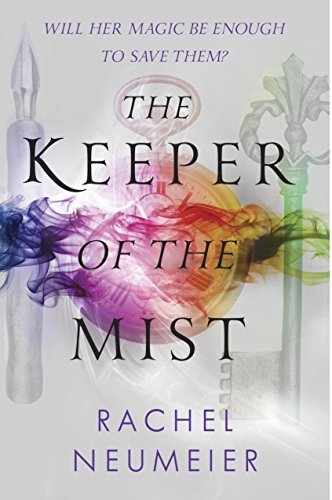
And then of course Keri inherits the title, plus the ambiguous powers, plus the increasingly dire problems. I’m sure every possible detail is completely different, but plainly this is a setup that appeals to me, so I guess I should take a look at The Lord of Stariel. Have any of you read it? What did you think?
Okay, so, what does Gaslamp Fantasy mean to you, if not: Historical fantasy set in the 19th century, not too silly in tone. That’s my working definition. I better quit before I bog down in an immense attempt to list (or worse, define) all possible fantasy subgenres. That way lies madness, as we all know, though attempts can be fun as long as you’re prepared to throw up your hands and quit before dotting every single “i” and crossing each and every “t.”
For books to try in this subgenre, I personally suggest Sorcery and Cecilia as my personal favorite Gaslamp Fantasy. Goodness, that one has a great price right now; if you haven’t got it, consider picking it up immediately. This one is by Patricia Wrede and Carolyn Stevermer and it’s an absolutely delightful epistolary novel.
Or else Marelon the Magician. This one is by Patricia Wrede on her own and I’m not sure, but I may like it even better than the above. There’s a wonderful scene at the end, the one where everything gets sorted out and the two brothers reconcile, that I wish I’d written. I love that scene a whole lot.
In both cases, there are sequels. In both cases, I think the first books are the best, and they each stand alone, so if you wanted to try one or the other series, or both of them, that’s a fine idea.
If you’ve got a favorite Gaslamp Fantasy, by all means drop it in the comments!
Please Feel Free to Share:






The post The Evolution of Gaslamp Fantasy appeared first on Rachel Neumeier.
If you’re Enjoying the Puppy Posts
I can’t get my phone to send this video to my email, but I CAN get it to upload videos to Facebook. HERE is a super-cute video of Puppies One and Three playing with Naamah.
If you don’t have time to watch even a very short and very cute video — you should enable the volume, by the way, because their tiny puppy barking is highly adorable — but here is a photo of Boy Three, totally crashed after playing

Plump Boy Three likes to sleep right next to the water dish, probably because it’s cooler there than on the dog bed. He’s going to tick over four pounds tomorrow, by the way.
Please Feel Free to Share:






The post If you’re Enjoying the Puppy Posts appeared first on Rachel Neumeier.
How to be a Beta Reader
Here’s a potentially useful post from Jane Friedman’s blog: Looking for a Beta Reader? Flip That Question Around.
Why do I argue for the flip? Two reasons:
Because helping each other is always a good thing (you’re not the only one with this dream!), andBecause the more you practice your editing skills, the stronger you will become as a writer.Which is true, sure, but I’m more interested right now in the practical suggestions for how to do a good job as a beta reader. Here they are:
Think about more than grammar, punctuation, and spelling perfection.Think about celebrating strengths just as much as pointing out areas needing more work.When you see an awesome line, celebrate it.When you love a character, let the writer know.When you’re terrified or swooning or utterly fascinated, applaud how the scene is crafted.Think about specific notes that could be helpful to the writer.Where are you confused?Where does the story seem to wander off-focus?Where is a motivation or a plot twist unclear?Where does the story seem slow?When you finish, see if you can articulate what the book was about (the plot) in three sentences or fewer and what you saw as the overarching theme or takeaway. (The writer will be inspired when your understanding matches their own, or if it doesn’t, that too can be telling!)Think about what would be helpful to you if you were the writer receiving feedback.Critique with kindness not brutality.Remember you are in “editor” mode, not a “ghostwriter” tasked with rewriting anything as you would do it.I’m interested in this right now because (a) I’m currently beta reading a manuscript for Sherwood Smith; and (b) I’ve got workshop critiques to write for a workshop that’s taking place in July; and (c) I’m just curious because my expectations for various first readers are quite different. Let’s take a look at the above …
Okay, here’s my takeaway:
Yes, first, it’s easy to get distracted by tiny queries about grammar, punctuation, and syntax. Do you want this one sentence to be in the present tense? Why? is a legitimate query, but very small scale. If you are just proofreading, that’s useful, but it’s not the same as beta reading. Beta reading is, or can be, a lot more like editing than proofreading.
Second: yes again. It’s very nice for the author if you cheer nice phrases, good description, effective lines of dialogue, etc. I’m saying this from personal experience. Please don’t hesitate to put in little smiley faces and nice little “wonderful” comments in the margin. That’s a great thing to do. Thank you for doing that.
Third: yes, when you feel iffy about something, train yourself not to make an excuse for that iffy section. “Oh, I’m sure it’s really all right,” is fine from a reader, but not great from a beta reader. Pause and add a comment. If you can figure out what you don’t like, that’s fine (“I suddenly lost interest and found myself skimming through this part.” “I suddenly can’t stand this character after she did this.” “Oh my God, he would NEVER do this!”) If you can’t figure out what you don’t like, you can still add a comment (“Something here isn’t working for me, but I’m not sure why.”
Fourth: I hadn’t thought about pausing to summarize or articulate the theme. I’m terrible at spotting themes, but sure, it’s neat when a reader comments in a review, “The powerful theme of ….” and is completely and obviously right that this is one of the themes.
Fifth: Yes, resist the urge to rewrite the sentences. It’s not your book.
And finally, not from the above, different first readers are good at different things and that’s fine.
When I ask someone if they have time to read something for me — a request that everyone should always answer with NO if they do not have time; I completely understand that — but sometimes what I’m looking for are broad emotional reactions to different scenes. Does the scene really nail it for you or is it off? If you can put a finger on why a scene doesn’t feel quite right to you — maybe it feels truncated or something — that’s fine, but it’s also fine if you just are doubtful about that scene, period. That’s what I want. That’s plenty to help me re-focus on what is going on in that scene and think about ways to possibly make the scene more effective.
On the other hand, I might be looking for editorial feedback about pacing, places where the worldbuilding feels thin, or feedback about awkward sentences or phrases. Or maybe all I want to know is whether the relationships ring true — maybe that’s someone’s particular focus and I want to make sure that the central relationships are working. Or whether the story feels finished, does the conclusion feel like a conclusion, maybe THAT is the one thing I most want to know.
I’ve seen suggestions — I don’t remember where — that you should have a bunch of beta readers, including some that don’t really read your genre and at least one who doesn’t really like your writing. (I think that’s weird advice.) I don’t know; to me, it seems that a couple beta readers are plenty, but someone needs to have good editorial skills and someone has to get what you’re trying to do with relationships and provide feedback just about that. Those are the two crucial types of beta readers as far as I’m concerned. The first person says, “You’ve said this before, this is repetitious, can you cut these two paragraphs?” The second says, “Oh, this poor guy, I just want to give him all the hugs!” Both are really valuable feedback.
And THEN proofreading, which as you all know is simultaneously invaluable and hopeless. I sent myself SUELEN as a mobi file so I could read it on my phone, which I did very slowly over the past week, and you know what? I found about thirty sentences to fiddle with and THREE MORE ACTUAL ERRORS. Well, surely that’s the last of the actual typos! (I am fairly sure it will turn out not to be the very, very last ones).
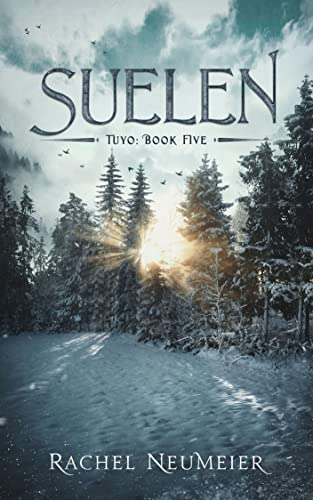 Please Feel Free to Share:
Please Feel Free to Share:







The post How to be a Beta Reader appeared first on Rachel Neumeier.
June 8, 2022
Character Voice
Here’s a good post from Writers Helping Writers: 3 Ways to Infuse Character Voice
Vocabulary and the way a character speaks are the outer layer of character voice—the icing on the cake. Instead of trying to build character voice from the outside in, get under the character’s skin by revealing how they experience and interpret the story world from the inside out. …
The three ways, incidentally, are what the character notices, their opinions about what they notice, and what actually matters to them.
What you know is inside a room will almost certainly be different from what the viewpoint character notices. What gets noticed depends on who does the noticing. Everyone sees the world through the lens of their own mindset, a potent brew of knowledge, experience, motivations, goals, preferences, hopes, fears …
People are opinionated. They have beliefs, and hopes, and prejudices about virtually everything they encounter. …
I’m not sure it’s possible to have a truly reliable first-person protagonist. That specific person is going to have, by definition, their own individual point of view, which includes, yes, their beliefs and hopes and prejudices; their expectations about how the world works and what people are like; their own feelings about how people ought to behave and the standards against which they judge everyone … all of that is indeed beneath the vocabulary and syntax that the author gives that protagonist. Same with close third; everything in the story is seen through the perceptions and attitudes and beliefs and expectations of the protagonist.
Omniscient viewpoint allows the author to step back from the protagonist(s) and, by showing the reader everyone’s perceptions, attitudes, believes, and expectations, prevents the voice of any one character from pervading the narrative. Of course, if you take that far enough, the omniscient narrator then takes on life and acquires a distinctive voice too.
Syntax and vocabulary do matter, however. This is a somewhat different topic, or a different aspect of the same topic, but I was thinking about that recently, because I heard someone comment (as seems to happen constantly) that no one these days uses “whom.” Yes, we do, and you know who particularly uses “whom” in their casual, ordinary conversation? Your super-formal characters in your novels, that’s who. All mistakes and non-formal locutions become jarring if placed in the mouth of a character who ought to, and usually does, speak with a formal style. They are jarring because they do not match the established voice of the character or because they prevent that character from establishing a credible voice in the first place.
If the author can’t use formal syntax herself, she will never be able to write a character who is convincingly formal. That’s a painful limitation to impose on yourself, which is why authors ought to learn how to use “whom” correctly; and the subjunctive mood; and “less” versus “fewer,” and whatever other features we expect in formal English and don’t necessarily expect in less formal contexts or from informal speech.
… and while on this topic, I will just say that the worst offender is incorrect “him and I” constructions. I am thinking right now of multiple examples of important characters who should not make that kind of mistake, but do, and neither the author, the copy editors, the proofreaders, or the beta readers caught it. Or if someone caught it, they didn’t think it was important.
Wrong. It is important. The author should know how to shift into formal locutions no matter how casual speech is put together in everyday life and no matter how less formal characters might speak. Mistakes like this can do brutal damage to the voice of a character who ought not make this kind of error.
I therefore nominate this specific mistake as Top Mistake To Make Sure You Fix If You Are Writing A Novel. Here is a post about this error. Here’s another. And another. If you’re going to put this kind of error into the mouth of a character, fine, but you should do it on purpose because that’s the way that character ought to speak, not because you yourself don’t know the correct form.
Please Feel Free to Share:






The post Character Voice appeared first on Rachel Neumeier.
June 7, 2022
Update to the Use of Medieval Weaponry
Here’s a question on Quora on this very topic, answered by Eric Lowe: What were the relative advantages and disadvantages of various medieval weapons? How do I decide if I should use a sword, a spear, a mace, or a battle axe?
Eric begins:
Man … this is, like, the ur-question for the medieval weapons section of Quora.
I love that this question isn’t trying to reduce things to a simplistic “which is better?” or, even worse, “which would win?” framework. Kudos on asking about relative advantages, which is the only reasonable answer you can give to the “which would win?” questions anyway.
I’ve spent six years on Quora answering smaller versions of this question. I think this is the first time someone has just come out and asked the big question directly.
So, this is all in Lowe’s book, but if you haven’t yet bought The Use of Medieval Weaponry, this answer provides a very brief review of when and in what situations these weapons might be used. With footnotes! And links!
Please Feel Free to Share:






The post Update to the Use of Medieval Weaponry appeared first on Rachel Neumeier.
I can’t decide whether this is charming or too silly to be charming
I enjoyed on Quora. The question: What has a name that also describes what it does.
The answer: The Useless Box.
It’s a box. And it’s useless.
Click through and watch the video. Would you like a Useless Box? Or is it too silly for you? I can’t quite decide. However, if you’d like one, they’re apparently available from Amazon.
I’m filing this under What Will They Think Of Next.
Please Feel Free to Share:






The post I can’t decide whether this is charming or too silly to be charming appeared first on Rachel Neumeier.



